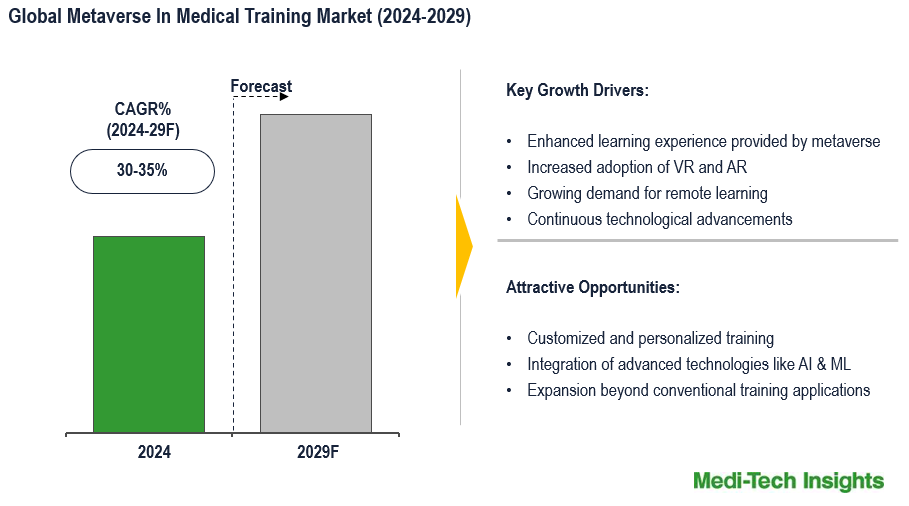Global Metaverse in Medical Training Market to Surge 8-9% CAGR by 2029

The Rise of the Global metaverse in Medical Training: Projected Growth and Key Drivers
Overview of Market Growth
The Global metaverse in Medical Training sector is anticipated to experience a growth trajectory of 8-9% over the next five years. This expansion is largely attributed to the enhanced educational experiences offered by the metaverse, the increasing integration of virtual reality (VR) and augmented reality (AR), a rising demand for remote learning solutions, and the cost-effective training alternatives that the metaverse provides. However, challenges such as high initial costs, technical hurdles, regulatory and ethical concerns, and resistance to adopting new technologies may impede this growth.
- Overview of Market Growth
- Understanding the metaverse in Medical Training
- Enhanced Learning Experiences Driving Market Expansion
- The Role of VR and AR in Market Growth
- The Impact of Immersive 3D Learning
- The United States as a Growth Leader
- Analysis of Offering Types
- End User Segment Insights
- Growth Strategies of Key Players
- Competitive Landscape
- Future Outlook
- About Medi-Tech Insights
Understanding the metaverse in Medical Training
The concept of the metaverse in medical training encompasses an immersive digital ecosystem that significantly enriches the educational journey for healthcare professionals. Utilizing advanced technologies like VR, AR, and mixed reality (MR), this innovative framework allows learners to engage with digital content and interact with peers in real-time, fostering a vibrant and interactive learning environment. The integration of the metaverse into medical education signifies a major leap forward in teaching methodologies, offering immersive, hands-on experiences that are more aligned with the demands of contemporary healthcare.
Enhanced Learning Experiences Driving Market Expansion
The metaverse is transforming medical training by providing an enriched learning environment. Through immersive 3D virtual settings, healthcare professionals can practice intricate procedures and hone their skills without the associated risks of real-life scenarios. This experiential learning approach enhances knowledge retention and skill proficiency compared to conventional training methods. Furthermore, the metaverse promotes collaborative learning, enabling medical students and professionals from diverse locations to engage in real-time, simulating authentic medical situations. This global connectivity is particularly advantageous for training in rare or complex cases, where expertise may be scattered. Additionally, the metaverse supports continuous, personalized learning through adaptive simulations tailored to individual progress, thereby increasing access to high-quality medical education.
The Role of VR and AR in Market Growth
The growing adoption of VR and AR technologies is a significant catalyst for the expansion of the metaverse in medical training. These technologies create immersive and interactive environments that replicate real-world medical situations within a controlled virtual framework. VR allows medical students and professionals to practice complex procedures, such as surgeries, in a fully immersive 3D space, enabling them to gain hands-on experience without the risks of actual practice. Repeatedly performing procedures in VR builds confidence and proficiency, especially in fields that require precision, like surgery. Conversely, AR enhances real-world experiences by overlaying digital information during medical procedures, providing real-time guidance that improves understanding and decision-making. The combination of VR and AR within the metaverse facilitates personalized learning experiences, making medical education more accessible and effective for a diverse range of learners.
The Impact of Immersive 3D Learning
Immersive 3D learning is emerging as a pivotal trend in the metaverse medical training market, offering a more engaging and interactive approach to medical education. Unlike traditional methods that rely heavily on textbooks and 2D illustrations, immersive 3D learning utilizes VR and AR technologies to provide students with lifelike, hands-on experiences. In these 3D environments, medical learners can explore human anatomy in detail, manipulating organs and tissues for a deeper understanding of complex systems. This is particularly advantageous for anatomy courses, where visualizing spatial relationships is crucial. The interactive nature of 3D models allows for precise examination and dissection, enhancing comprehension. For procedural training, immersive 3D learning simulates real-world scenarios, allowing trainees to practice surgeries and patient care without any risk to actual patients. This trend also encourages collaborative learning, as students and professionals can participate in virtual classrooms, sharing insights and working together on cases in real time.
The United States as a Growth Leader
The United States is poised to be a significant growth driver in the metaverse medical training market, thanks to its advanced technological infrastructure, substantial investments in healthcare innovation, and leading academic institutions. The country’s strong focus on research and development accelerates the adoption of cutting-edge technologies like VR and AR, which are essential to the metaverse. Medical schools and institutions across the U.S. are increasingly integrating metaverse platforms into their curricula, motivated by the need for innovative educational tools. Additionally, significant funding from private investors and government grants supports the development and implementation of these technologies. The U.S. also benefits from a large pool of healthcare professionals and students eager to engage with advanced training methods, further propelling market growth.
Analysis of Offering Types
The metaverse in medical training market can be segmented into three main categories: Hardware, Software, and Services. Software is projected to dominate the market due to the rising demand for advanced simulation platforms, virtual learning environments, and AI-driven personalized training systems. These software solutions are vital for creating immersive training experiences that allow medical professionals to practice procedures in a risk-free virtual environment. The services segment is also expected to see significant growth, as more medical institutions adopt metaverse technologies and require ongoing support for implementation and operation. Service providers play a crucial role in customizing solutions to meet specific institutional needs, further driving demand in this area.
End User Segment Insights
The metaverse in medical training market can be analyzed based on various end users, including Medical Universities & Institutions, Hospitals and Surgical Centers, Research & Academic Institutions, Pharmaceutical Companies, Medical Device Companies, and others. Medical Universities & Institutions represent the largest segment, as these entities are primary adopters of metaverse technologies, utilizing immersive simulations and virtual learning platforms to enhance medical education. The demand for VR and AR tools is high, as universities strive to provide students with interactive, hands-on training in anatomy, surgery, and patient care without relying on physical resources. The Hospitals and Surgical Centers segment is also expected to experience significant growth, driven by the need for improved surgical precision and reduced training costs.
Growth Strategies of Key Players
Market participants are employing both organic and inorganic growth strategies, such as collaborations, acquisitions, and new product launches, to enhance their market presence. For example:
- In July 2024, MediSim VR launched an immersive VR-training lab at Sri Ramachandra Institute of Higher Education and Research (SRIHER), India, benefiting over 4,000 students with hands-on medical training.
- In December 2023, Health On Cloud expanded its metaverse-based medical education platform, MEDTIS, to Latin America, offering virtual reality training in various medical fields.
- In March 2023, Medtronic and NVIDIA collaborated to integrate AI-driven technologies into medical training, enhancing real-time surgical procedures and medical imaging.
- In February 2023, Indegene launched metaverse capabilities to improve life sciences training, creating personalized virtual worlds for richer learning experiences.
Competitive Landscape
The global metaverse in medical training market features established players such as Accenture plc, Apple Inc., Brainlab AG, ImmersiveTouch, Inc., Indegene, Meta, Microsoft Corporation, NVIDIA Corporation, Oodles Technologies Pvt Ltd., Wipro Limited, and WorldViz, Inc., among others.
Future Outlook
The metaverse in medical training market is expected to gain further momentum in the coming years, driven by ongoing technological advancements, increased R&D investments, and aggressive growth strategies from key players in the industry.
About Medi-Tech Insights
Medi-Tech Insights specializes in healthcare-focused business research and insights, serving clients that include Fortune 500 companies, blue-chip investors, and rapidly growing startups. The firm has successfully completed over 100 projects in areas such as Digital Health, Healthcare IT, Medical Technology, Medical Devices, and Pharma Services, employing a rigorous research methodology that combines secondary research with in-depth interviews with industry leaders.







